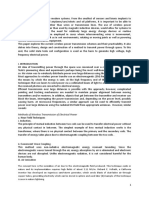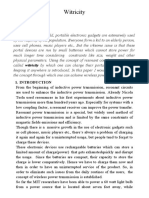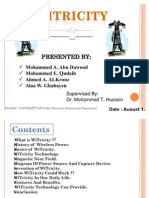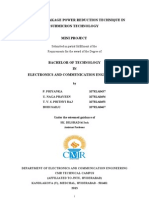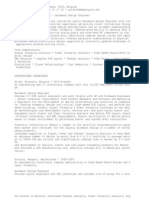Electricity Through Wireless Transmission - Development and Possibility
Electricity Through Wireless Transmission - Development and Possibility
Uploaded by
Sai ChandhraCopyright:
Available Formats
Electricity Through Wireless Transmission - Development and Possibility
Electricity Through Wireless Transmission - Development and Possibility
Uploaded by
Sai ChandhraOriginal Description:
Original Title
Copyright
Available Formats
Share this document
Did you find this document useful?
Is this content inappropriate?
Copyright:
Available Formats
Electricity Through Wireless Transmission - Development and Possibility
Electricity Through Wireless Transmission - Development and Possibility
Uploaded by
Sai ChandhraCopyright:
Available Formats
Electricity Through Wireless Transmission Development And Possibility
Abstract In the present paper the various technologies available so far for wireless transmission of electricity and the need for a Wireless System of Energy Transmission is being discussed to find its possibility in actual practices, their advantages, disadvantages and economical consideration. This paper is mainly concentrated on : i) The most popular concept known as Tesla Theory, ii) The microwave power transmission (MPT) called Solar power satellite, and iii) The highly efficient fibre lasers for wireless power transmission. Many concepts, research papers, patents are available on wireless transmission of electricity but the commercial technologies are yet to be materialized. The paper also discusses the possible ways to get useful and practical results out of all research carried out so far elsewhere. I. INTRODUCTION In our present electricity generation system we waste more than half of its resources. Especially the transmission and distribution losses are the main concern of the present power technology. Much of this power is wasted during transmission from power plant generators to the consumer. The resistance of the wire used in the electrical grid distribution system causes a loss of 2630% of the energy generated. This loss implies that our present system of electrical distribution is only 70-74% efficient. We have to think of alternate state - of - art technology to transmit and distribute the electricity. Now- a- days global scenario has been changed a lot and there are tremendous development in every field. If we dont keep pace with the development of new power technology we have to face a decreasing trend in the development of power sector.
The transmission of power without wires may be one noble alternative for electricity transmission. II. THE TECHNOLOGIES AVAILABLE - Near field These are wireless transmission techniques over distances comparable to, or a few times the diameter of the device(s).
Induction
An electric toothbrush's base and handle contain coils that allow the battery to recharge.
The action of an electrical transformer is the simplest instance of wireless energy transfer. The primary and secondary circuits of a transformer are not directly connected. The transfer of energy takes place by electromagnetic coupling through a process known as mutual induction. (An added benefit is the capability to step the primary voltage either up or down.) The battery charger of an electric toothbrush is an example of how this principle can be used. The main drawback to induction, however, is the short range. The receiver must be very
close to the transmitter or induction unit in order to inductively couple with it.
On June 7, 2007, it was reported that a prototype system had been implemented. The MIT researchers successfully demonstrated the ability to power a 60-watt light bulb from a power source that was seven feet (2 meters) away at roughly 40% efficiency. "Resonant inductive coupling" has key implications in solving the two main problems associated with non-resonant inductive coupling and electromagnetic radiation, one of which is caused by the other; distance and efficiency. Electromagnetic induction works on the principle of a primary coil generating a predominantly magnetic field and a secondary coil being within that field so a current is induced within its coils. This causes the relatively short range due to the amount of power required to produce an electromagnetic field. Over greater distances the non-resonant induction method is inefficient and wastes much of the transmitted energy just to increase range. This is where the resonance comes in and helps efficiency dramatically by "tunneling" the magnetic field to a receiver coil that resonates at the same frequency. Unlike the multiple-layer secondary of a non-resonant transformer, such receiving coils are single layer solenoids with closely spaced capacitor plates on each end, which in combination allow the coil to be tuned to the transmitter frequency thereby eliminating the wide energy wasting "wave problem" and allowing the energy used to focus in on a specific frequency increasing the range. Beginning in the early 1960s resonant inductive wireless energy transfer was used successfully in implantable medical devices including such devices as pacemakers and artificial hearts. While the early systems used a resonant receiver coil later systems implemented resonant transmitter coils as
A Splash power mat uses induction to recharge multiple devices simultaneously.
Resonant induction In 2006, Marin Soljai and other researchers at the Massachusetts Institute of Technology applied the near field behaviour well known in electromagnetic theory to a wireless power transfer concept based on coupled resonators. In a theoretical analysis, they demonstrate that by sending electromagnetic waves around in a highly angular waveguide, evanescent waves are produced which carry no energy. If a proper resonant waveguide is brought near the transmitter, the evanescent waves can allow the energy to tunnel (specifically evanescent wave coupling, the electromagnetic equivalent of tunneling) to the power drawing waveguide, where they can be rectified into DC power. Since the electromagnetic waves would tunnel, they would not propagate through the air to be absorbed or dissipated, and would not disrupt electronic devices or cause physical injury like microwave or radio wave transmission might. Researchers anticipate up to 5 meters of range for the initial device, and are currently working on a functional prototype.
well. These medical devices are designed for high efficiency using low power electronics while efficiently accommodating some misalignment and dynamic twisting of the coils. The separation between the coils in implantable applications is commonly less than 20 cm. Today resonant inductive energy transfer is regularly used for providing electric power in many commercially available medical implantable devices. Wireless electric energy transfer for experimentally powering electric automobiles and buses is a higher power application (>10kW) of resonant inductive energy transfer. High power levels are required for rapid recharging and high energy transfer efficiency is required both for operational economy and to avoid negative environmental impact of the system. An experimental electrified roadway test track built circa 1990 achieved 80% energy efficiency while recharging the battery of a prototype bus at a specially equipped bus stop. The bus could be outfitted with a retractable receiving coil for greater coil clearance when moving. The gap between the transmit and receive coils was designed to be less than 10 cm when powered. In addition to buses the use of wireless transfer has been investigated for recharging electric automobiles in parking spots and garages as well. Some of these wireless resonant inductive devices operate at low milli Watt power levels and are battery powered. Others operate at higher kilowatt power levels. Current implantable medical and road electrification device designs achieve more than 75% transfer efficiency at an operating distance between the transmit and receive coils of less than 10 cm. Far field
Means for long conductors of electricity forming part of an electric circuit and electrically connecting said ionized beam to an electric circuit. These methods achieve longer ranges, often multiple kilometre ranges, where the distance is much greater than the diameter of the device(s). Radio and microwave The earliest work in the area of wireless transmission via radio waves was performed by Heinrich Rudolf Hertz in 1888. A later Guglielmo Marconi worked with a modified form of Hertz's transmitter. Nikola Tesla also investigated radio transmission and reception. Japanese researcher Hidetsugu Yagi also investigated wireless energy transmission using a directional array antenna that he designed. In February 1926, Yagi and Uda published their first paper on the tuned highgain directional array now known as the Yagi antenna. While it did not prove to be particularly useful for power transmission, this beam antenna has been widely adopted throughout the broadcasting and wireless telecommunications industries due to its excellent performance characteristics. High power In this remarkable discovery of the "True Wireless" and the principles upon which transmission and reception, even in the present day systems, are based, Dr. Nikola Tesla shows us that he is indeed the "Father of the Wireless." The most well known and famous Wardenclyffe Tower (Tesla Tower) was designed and constructed mainly for wireless transmission of electrical power, rather than telegraphy. The most popular concept known is Tesla Theory in which it
was firmly believed that Wardenclyffe (Fig.1) would permit wireless transmission and reception across large distances with negligible losses. In spite of this he had made numerous experiments of high quality to validate his claim of possibility of wireless transmission of electricity (Fig.2). But this was an unfortunate incidence that people of that century was not in a position to recognise his splendid work otherwise today we may transmit electricity wirelessly and will convert our mother earth a wonderful adobe full of electricity.
Fig.2. The basis for Teslas system for the wireless transmission of electrical power. William C. Brown, the leading authority on wireless power transmission technology, has loaned this demonstration unit to the Texas Space Grant Consortium to show how power can be transferred through free space by microwaves. A block diagram of the demonstration components is shown below. The primary components include a microwave source, a transmitting antenna, and a receiving rectenna.
Fig.1. The 187-foot Wardenclyffe Tower (Tesla Tower) in 1903. This was to be the first broadcasting system in the world. Tesla wanted to transmit electricity from this Tower to the whole globe without wires using the Ionosphere. The source of the transmitted electricity was to be the Niagara Falls power plant. The modern ideas are dominated by microwave power transmission (MPT, Figure 3) called Solar power satellite to be built in high earth orbit to collect sunlight and convert that energy into microwaves, then beamed to a very large antenna on earth, the microwaves would be converted into conventional electrical power.
Fig.3 .Microwave power transmission. The microwave source consists of a microwave oven magnetron with electronics to control the output power. The output microwave power ranges from 50 W to 200 W at 2.45 GHz. A coaxial cable connects the output of the microwave source to a coax-towaveguide adapter. This adapter is connected to a waveguide ferrite circulator which protects the microwave source from reflected power. The circulator is connected
to a tuning waveguide section to match the waveguide impedance to the antenna input impedance. The slotted waveguide antenna consists of 8 waveguide sections with 8 slots on each section. These 64 slots radiate the power uniformly through free space to the rectenna. The slotted waveguide antenna is ideal for power transmission because of its high aperture efficiency (> 95%) and high power handling capability. A rectifying antenna called a rectenna receives the transmitted power and converts the microwave power to direct current (DC) power. This demonstration rectenna consists of 6 rows of dipoles antennas where 8 dipoles belong to each row. Each row is connected to a rectifying circuit which consists of low pass filters and a rectifier. The rectifier is a Ga As Schottky barrier diode that is impedance matched to the dipoles by a low pass filter. The 6 rectifying diodes are connected to light bulbs for indicating that the power is received. The light bulbs also dissipated the received power. This rectenna has a 25% collection and conversion efficiency, but rectennas have been tested with greater than 90% efficiency at 2.45 GHz. The transmission of power without wires is not a theory or a mere possibility, it is now a reality. The electrical energy can be economically transmitted without wires to any terrestrial distance, many researchers have established in numerous observations, experiments and measurements, qualitative and quantitative. These have demonstrated that it is practicable to distribute power from a central plant in unlimited amounts, with a loss not exceeding a small fraction of one per cent, in the transmission, even to the greatest distance, twelve thousand miles - to the opposite end of the globe. This seemingly impossible feat can now be readily performed by electrical researchers familiar with the design and construction of
my "high-potential magnifying transmitter," There were three popular theories present in the literature of the late 1800's and early 1900's. They were: 1. Transmission through or along the Earth, 2. Propagation as a result of terrestrial resonances, 3. Coupling to the ionosphere using propagation through electrified gases(Fig.4&5).
Fig.4. Diagram showing the transmitting & receiving circuit for the transmission & reception of electric power by wireless.
Fig.5. Two optical forms of wireless antennae formed of search light beamionised atmospheric streams. Low power A new company, Powercast introduced wireless power transfer technology using RF energy at the 2007 Consumer Electronics Show, winning best Emerging Technology. The Powercast system is applicable for a number of devices with low power requirements. This could include LEDs, computer peripherals, wireless sensors, and
medical implants. Currently, it achieves a maximum output of 6 volts for a little over one meter. It is expected for arrival late 2007. A different low-power wireless power technology has been proposed by Landis.
Knowing that a resonant cavity can be excited and that power can be delivered to that cavity similar to the methods used in microwave ovens for home use, it should be possible to resonate and deliver power via the Schumann Cavity to any point on Earth. This will result in practical wireless transmission of electrical power. The intent of the experiments and the laboratory Tesla had constructed was to prove that wireless transmission of electrical power was possible. Although Tesla was not able to commercially market a system to transmit power around the globe, modern scientific theory and mathematical calculations support his contention that the wireless propagation of electrical power is possible and a feasible alternative to the extensive and costly grid of electrical transmission lines used today for electrical power distribution. Power transmission system using directional ultrasound for power transmission includes a transmitting device and a receiving device. The transmitting device has a set of ultrasound transducers forming an ultrasound transducer array, wherein the array is a set of spaced individual transducers placed in the X-Y plane disposed to generate an ultrasound beam in the Z direction (Fig.6). Another possibility is to use highly efficient fibre lasers for wireless power transmission where the possibilities are similar to microwaves concept but lasers emit energy at frequencies much higher that microwaves. For several years NASA, ENTECH, and UAH have been working on various aspects of collection of the laser radiation and conversion to electrical power for laser wireless power transmission.
Laser
With a laser beam centered on its panel of photovoltaic cells, a lightweight model plane makes the first flight of an aircraft powered by a laser beam inside a building at NASA Marshall Space Flight Center. In the case of light, power can be transmitted by converting electricity into a laser beam that is then fired at a solar cell receiver. This is generally known as "powerbeaming". Its drawbacks are: 1. Conversion to light, such as with a laser, is moderately inefficient (although quantum cascade lasers improve this) 2. Conversion back into electricity is moderately inefficient, with photovoltaic cells achieving 40%50% efficiency. (Note that conversion efficiency is rather higher with monochromatic light than with insolation of solar panels). 3. Atmospheric absorption causes losses. 4. As with microwave beaming, this method requires a direct line of sight with the target. NASA has demonstrated flight of a lightweight model plane powered by a laser beam.It has been proven that electrical energy can be propagated around the world between the surface of the Earth and the ionosphere at extreme low frequencies in what is known as the Schumann Cavity.
Fig.6. System and method for wireless electrical power Transmission (directional ultrasound for power Transmission). III. MERITS, DEMERITS & ECONOMICS OF WIRELESS TECHNOLOGIES Merits An electrical distribution system, based on this method would eliminate the need for an inefficient, costly, and capital intensive grid of cables, towers, and substations. The system would reduce the cost of electrical energy used by the consumer and rid the landscape of wires, cables, and transmission towers. There are areas of the world where the need for electrical power exists, yet there is no method for delivering power. Africa is in need of power to run pumps to tap into the vast resources of water under the Sahara Desert. Rural areas, such as those in China, require the electrical power necessary to bring them into the 20th century and to equal standing with western nations. The wireless transmission will solve many of these problems The electrical energy can be economically transmitted without wires to any terrestrial distance, so there will be no transmission and distribution loss. More efficient energy distribution systems and sources are needed by both developed and under developed nations. In regards to the new systems, the market for wireless power transmission is enormous. It has the
potential to become a multi-billion dollar per year market. The increasing demand for electrical energy in industrial nations is well documented. If we include the demand of third world nations, pushed by their increasing rate of growth, we could expect an even faster rise in the demand for electrical power in the near future. These systems can only meet these requirements with 9094 %efficient transmission. High Transmission Integrity and Low Loss: - To transmit wireless power to any distance without limit. It makes no difference what the distance is. The efficiency of the transmission can be as high as 96 or 97 per cent, and there are practically no losses. Demerits Biological Impact: - One common criticism of the Tesla wireless power system is regarding its possible biological effects. Calculating the circulating reactive power, it was found that the frequency is very small and such a frequency is very biologically compatible. Economic Impact The concept looks to be costly initially. The investment cost of Tesla Tower was $150,000 (1905). In terms of economic theory, many countries will benefit from this service. Only private, dispersed receiving stations will be needed. Just like television and radio, a single resonant energy receiver is required, which may eventually be built into appliances, so no power cord will be necessary! Monthly electric utility bills from old-fashioned, fossil-fuelled, loss prone electrified wire-grid delivery services will be optional, much like cable TV of today. In the 21st century, Direct TV is the rage, which is an exact parallel of Teslas Direct Electricity.
IV. ADDITIONAL REMARKS Many concepts, research papers, patents are available on wireless transmission of electricity but most research work were carried out in isolation, so it needs a joint collaborative efforts to get a very useful results on this advanced technology on power transmission for the benefit of mankind globally in future. Whatever the future may bring, the universal application of these great principles is fully assured, though it may be long in coming. With the opening of the first power plant, incredulity will give way to wonderment, and this to ingratitude, as ever before. The world is still not able to achieve the benefit of the God gifted potential of Dr N.Tesla. People neglected him and his good work. He deserved much better treatment from the tycoons of his age, than to spend the last 40 years of his life in abject poverty. However, he was too much of a gentleman to hold a grudge. Instead, regarding the magnifying transmitter, Tesla wrote in his autobiography, I am unwilling to accord to some small-minded and jealous individuals the satisfaction of having thwarted my efforts. These men are to me nothing more than microbes of a nasty disease. My project was retarded by laws of nature. The world was not prepared for it. It was too far ahead of time. But the same laws will prevail in the end and make it a triumphal success. If this has had not been happened, then today we will be in a wonder world of plenty of power using the technology of wireless transmission of electricity. V. CONCLUSION The transmission of power without wires is not a theory or a mere possibility, it is now a reality. The electrical energy can be economically transmitted without wires to any terrestrial distance. Many researchers
have established in numerous observations, experiments and measurements, qualitative and quantitative. Wireless transmission of electricity have tremendous merits like high transmission integrity and Low Loss (90 97% efficient) and can be transmitted to any where in the globe and eliminate the need for an inefficient, costly, and capital intensive grid of cables, towers, and substations. The system would reduce the cost of electrical energy used by the consumer and get rid of the landscape of wires, cables, and transmission towers. It has negligible demerits like reactive power which was found insignificant and biologically compatible. It has a tremendous economic impact to human society. Many countries will benefit from this service. Monthly electric utility bills from old-fashioned, fossil-fuelled, loss prone electrified wire-grid delivery services will be optional, much like cable TV of today. REFERENCES 1. Nikola Tesla, The Transmission of Electrical Energy Without Wires as a Means for Furthering Peace, Electrical World and Engineer. Jan. 7, p. 21, 1905. 2. Nikola Tesla, My Inventions, Ben Johnston, Ed., Austin, Hart Brothers, p. 91,1982. 3. Thomas F. Valone, Teslas Wireless Energy... For the 21st Century!!! One Step Beyond Direct TV!!! Extra Ordinary Technology, 1, no. 4, Oct / Nov / Dec 2003. 4. James O. McSpadden, Wireless Power Transmission Demonstration, Texas A&M University, June, 1997.
You might also like
- Trilogy of Wireless Power: Basic principles, WPT Systems and ApplicationsFrom EverandTrilogy of Wireless Power: Basic principles, WPT Systems and ApplicationsNo ratings yet
- Service Manual: KDL-32XBR9 KDL-32XBR9 KDL-40V5100 KDL-40V5100 KDL-46V5100 KDL-46V5100Document114 pagesService Manual: KDL-32XBR9 KDL-32XBR9 KDL-40V5100 KDL-40V5100 KDL-46V5100 KDL-46V5100Fabian Soto MontañoNo ratings yet
- Introduction to Electricity Supply and Regulation in IndiaFrom EverandIntroduction to Electricity Supply and Regulation in IndiaNo ratings yet
- Antenna DvorDocument27 pagesAntenna DvorRhonny AlbertoNo ratings yet
- It Is Quite Another Electricity: Transmitting by One Wire and Without GroundingFrom EverandIt Is Quite Another Electricity: Transmitting by One Wire and Without GroundingRating: 4.5 out of 5 stars4.5/5 (2)
- Electricity Through Wireless Transmission - Development and PossibilityDocument9 pagesElectricity Through Wireless Transmission - Development and PossibilitySuresh PanchalNo ratings yet
- WPT ReportDocument11 pagesWPT ReportAnirban SamantaNo ratings yet
- Wireless Transmission 1Document8 pagesWireless Transmission 1Govardhan RatnaNo ratings yet
- Wireless Transmission of Electricity - Development and PossibilityDocument8 pagesWireless Transmission of Electricity - Development and PossibilityshreenlNo ratings yet
- v1s1 2Document6 pagesv1s1 2Editorijset IjsetNo ratings yet
- Wireless Transmission of Electricity: Presented byDocument6 pagesWireless Transmission of Electricity: Presented byGovardhan RatnaNo ratings yet
- Methods of Wireless Transmission of Electrical PowerDocument11 pagesMethods of Wireless Transmission of Electrical PowerEsteria ChristinaNo ratings yet
- Wireless Transmission of Electricity - Development and PossibilityDocument6 pagesWireless Transmission of Electricity - Development and PossibilityKavish JainNo ratings yet
- On WitricityDocument22 pagesOn WitricitySantosh KumarNo ratings yet
- Witricity: Abstract - Induction (Inductive CouplingDocument6 pagesWitricity: Abstract - Induction (Inductive CouplingBamidi SrujanaaNo ratings yet
- WIRELESS ElectricityDocument13 pagesWIRELESS ElectricityTapas Kumar OjhaNo ratings yet
- Witricity SeminarDocument30 pagesWitricity SeminarYadhu KrishnanNo ratings yet
- Project On WitricityDocument16 pagesProject On WitricityAshis karmakar100% (1)
- Witricity-Wireless Electricity: VNR Vignana Jyothi Institute of Engineering and TechnologyDocument12 pagesWitricity-Wireless Electricity: VNR Vignana Jyothi Institute of Engineering and TechnologyBen ShalomNo ratings yet
- Wireless Transmission Network: A ImagineDocument4 pagesWireless Transmission Network: A ImagineEditor IJSETNo ratings yet
- WitricityDocument4 pagesWitricitySanoop J NairNo ratings yet
- Wireless Power TransmisssionDocument8 pagesWireless Power TransmisssionAnanthuSibyNo ratings yet
- Presentation By: Santosh Lopez Nilesh NaikDocument15 pagesPresentation By: Santosh Lopez Nilesh NaikHari BabuNo ratings yet
- Wireless Transmission of ElectricityDocument8 pagesWireless Transmission of Electricityrajaece10No ratings yet
- Wireless Power Transfer Using High-Frequency Resonating CoilsDocument4 pagesWireless Power Transfer Using High-Frequency Resonating CoilsRishabh ChaurasiaNo ratings yet
- PS1 PresentationDocument18 pagesPS1 PresentationMd. Mosaddik RafiNo ratings yet
- Wireless Power Transfer NewDocument29 pagesWireless Power Transfer Newanand_kishormishra4No ratings yet
- Wireless Communication: (Wireless Energy Transfer, Its Application and Challenges in Its Commercialization)Document15 pagesWireless Communication: (Wireless Energy Transfer, Its Application and Challenges in Its Commercialization)Karan ThakkarNo ratings yet
- Wireless Power TransmissionDocument17 pagesWireless Power TransmissionNavyashreeNo ratings yet
- WITRICITYDocument19 pagesWITRICITYRakesh TiwariNo ratings yet
- Minor Project'12 Wireless Energy TransferDocument41 pagesMinor Project'12 Wireless Energy TransferPrasobh S NairNo ratings yet
- Mid Sem ReportDocument12 pagesMid Sem ReportAzpNo ratings yet
- ChayanDocument14 pagesChayanaaarghyaNo ratings yet
- Wireless Energy Transfer: Vikash Kumar (06/07/88) E & C Department S.O.E. CusatDocument30 pagesWireless Energy Transfer: Vikash Kumar (06/07/88) E & C Department S.O.E. CusatVikash KumarNo ratings yet
- Wireless Energy Transfer: Chandana - Ks & Harish E & C Department Govt - SKSJTI, Bangaluru-01Document24 pagesWireless Energy Transfer: Chandana - Ks & Harish E & C Department Govt - SKSJTI, Bangaluru-01Chandana Kumar100% (1)
- Witricity PresentationDocument26 pagesWitricity PresentationSamarth J Parikh100% (1)
- B WPT 1 PDFDocument20 pagesB WPT 1 PDFnirmala M.S.No ratings yet
- FCRAR2012 InductiveChargingDocument7 pagesFCRAR2012 InductiveChargingMuhammed HussainNo ratings yet
- Ossai Chapter 2Document14 pagesOssai Chapter 2Ossai IsraelNo ratings yet
- INTRODUCTION: in 1825 William Sturgeon Invented The Electromagnet, ADocument7 pagesINTRODUCTION: in 1825 William Sturgeon Invented The Electromagnet, Aprashant9960No ratings yet
- Wireless Energy TransferDocument16 pagesWireless Energy TransferJerry WinstenNo ratings yet
- MicrowavesDocument13 pagesMicrowaveschithambaram_nNo ratings yet
- Presentation On "Wireless Power Transmission"Document31 pagesPresentation On "Wireless Power Transmission"Vanitha GowdaNo ratings yet
- Seminar On: Wireless Energy TransferDocument30 pagesSeminar On: Wireless Energy TransferKomal MahajanNo ratings yet
- Advance Wireless Power Transfer SystemDocument5 pagesAdvance Wireless Power Transfer SystemhamzaNo ratings yet
- Electrodynamic Induction Near Field: SightDocument4 pagesElectrodynamic Induction Near Field: SightPriyanka SagarNo ratings yet
- WPTS 2Document6 pagesWPTS 21521Ghanshyam PatilNo ratings yet
- ISLAMIC UNIVERSITY OF GAZA, Electrical Engineering DepartmentDocument26 pagesISLAMIC UNIVERSITY OF GAZA, Electrical Engineering DepartmentAnwin PaulyNo ratings yet
- WitricityDocument23 pagesWitricityabhishek_best90No ratings yet
- Physics ProjectDocument18 pagesPhysics ProjectShaunNo ratings yet
- Wireless ChargingDocument31 pagesWireless ChargingAbhinav Raj100% (1)
- Manish CS Seminar Report-1 Manish CS Seminar Report-1Document36 pagesManish CS Seminar Report-1 Manish CS Seminar Report-1Omkar SangoteNo ratings yet
- Wireless Recharging/Transmission Technology: Submitted by C Somaskhandan MBA-1 Year Vgsom IIT KharagpurDocument13 pagesWireless Recharging/Transmission Technology: Submitted by C Somaskhandan MBA-1 Year Vgsom IIT Kharagpurcater101No ratings yet
- Seminar Report On Wireless Power TransmissionDocument24 pagesSeminar Report On Wireless Power TransmissionsujiezNo ratings yet
- WITRICIT1Document2 pagesWITRICIT1Anupam ShekhawatNo ratings yet
- Witricity AbstractDocument6 pagesWitricity AbstractdemuthuNo ratings yet
- WirelessDocument36 pagesWirelesssakeshanpNo ratings yet
- Wireless Transmission of ElectricityDocument7 pagesWireless Transmission of ElectricitydivssanNo ratings yet
- Wireless Power TransmissionDocument6 pagesWireless Power Transmissionue204017.ashish.eeeNo ratings yet
- Introduction to Electronic Circuits: Unlocking the Power of ElectricityFrom EverandIntroduction to Electronic Circuits: Unlocking the Power of ElectricityNo ratings yet
- U9C-50 KNDocument8 pagesU9C-50 KNGMAR ComercializadoraNo ratings yet
- Nokia 6131nfc (Rm-216) Schematics SCHDocument12 pagesNokia 6131nfc (Rm-216) Schematics SCHChris ScribsNo ratings yet
- RC Snubber Circuit Design For Thyristor Using Turn-Off Model in PspiceDocument5 pagesRC Snubber Circuit Design For Thyristor Using Turn-Off Model in PspiceIjsrnet EditorialNo ratings yet
- VHF Omni Dipole 118 ÷ 137 MHZ 2dbi: Electrical SpecificationsDocument1 pageVHF Omni Dipole 118 ÷ 137 MHZ 2dbi: Electrical SpecificationsShams-ul ArifinNo ratings yet
- Tutorial Chapter 2Document4 pagesTutorial Chapter 2zulNo ratings yet
- SCT 013Document1 pageSCT 013SilvioNo ratings yet
- Serial and UART Tutorial: 1. The UART: What It Is and How It WorksDocument17 pagesSerial and UART Tutorial: 1. The UART: What It Is and How It WorksAnjireddy ThatiparthyNo ratings yet
- Onkyo tx-nr636Document108 pagesOnkyo tx-nr636ezeicom.fm4879No ratings yet
- PL4009规格书Document4 pagesPL4009规格书Nemo StevoNo ratings yet
- McpuDocument6 pagesMcputpsa6668No ratings yet
- GLR Adc en PDFDocument7 pagesGLR Adc en PDFLuis Álvarez JátivaNo ratings yet
- Flir t660 Datasheet PDFDocument16 pagesFlir t660 Datasheet PDFjosesm13No ratings yet
- EE 332 Lab3 v2 - 1Document35 pagesEE 332 Lab3 v2 - 1Ngotranduc ThangNo ratings yet
- Low PowerDocument48 pagesLow PowerRákêsh Råkêë100% (1)
- 9355 SpecDocument1 page9355 SpecTrung DangNo ratings yet
- Signal Integrity Engineer or Power Integrity Engineer or HardwarDocument3 pagesSignal Integrity Engineer or Power Integrity Engineer or Hardwarapi-121403633No ratings yet
- 01-High Voltage DC-EEE-IIUCDocument32 pages01-High Voltage DC-EEE-IIUCet191010No ratings yet
- Design and Implementation of Solar Coin Based Mobile ChargerDocument46 pagesDesign and Implementation of Solar Coin Based Mobile ChargersujathaNo ratings yet
- Computer FundamentalsDocument98 pagesComputer FundamentalsAnthony LoñezNo ratings yet
- Optimal PWM For 3L-NPC-brucknerDocument8 pagesOptimal PWM For 3L-NPC-brucknerharkoneneNo ratings yet
- NTBT-918: 2-Band 9 Volt or 18 Volt Preamp/Tone ControlDocument2 pagesNTBT-918: 2-Band 9 Volt or 18 Volt Preamp/Tone ControlRoman Cordova PerezNo ratings yet
- Reference Essay Computer)Document4 pagesReference Essay Computer)Trane SamNo ratings yet
- Design and Optimization of An Antenna Using CST Microwave Studio and ModeFRONTIERDocument18 pagesDesign and Optimization of An Antenna Using CST Microwave Studio and ModeFRONTIERАнатолий ДудушNo ratings yet
- SeminarDocument4 pagesSeminarmukulNo ratings yet
- Mobile Antenna System HandbookDocument15 pagesMobile Antenna System HandbookGuadalajara JaliscoNo ratings yet
- Opis Kodu Błędu p32 MXM/TMDocument4 pagesOpis Kodu Błędu p32 MXM/TMrafal1844No ratings yet
- Fault Tolerance in FPGA Through Horse Shifting PDFDocument5 pagesFault Tolerance in FPGA Through Horse Shifting PDFNoah OkitoiNo ratings yet
- Phan 1-Transistor-MDT-HK1 (23-24)Document64 pagesPhan 1-Transistor-MDT-HK1 (23-24)Tiến Đức 2004 LêNo ratings yet











